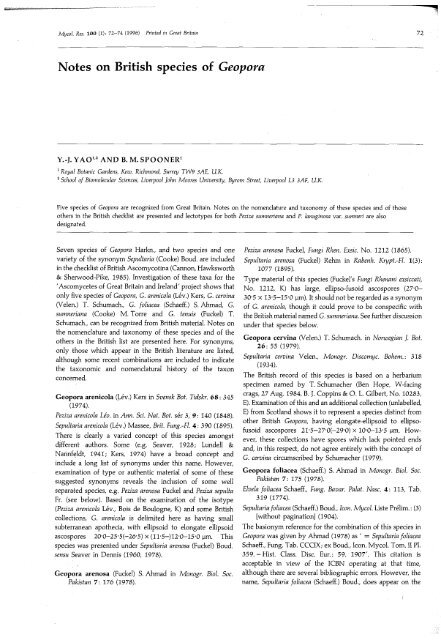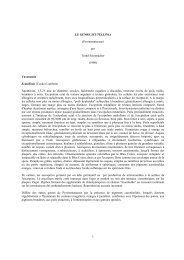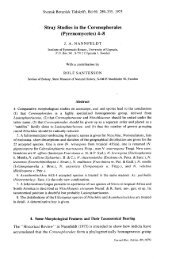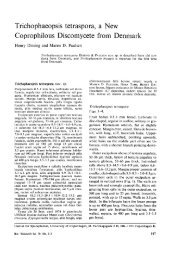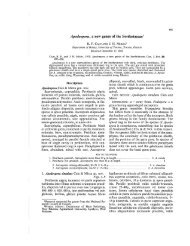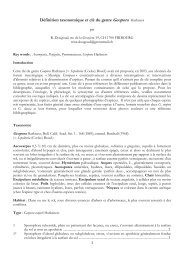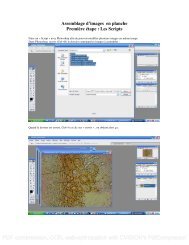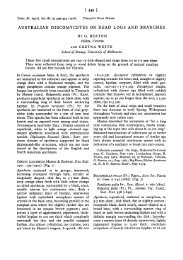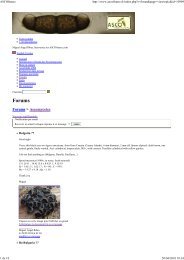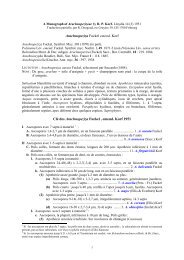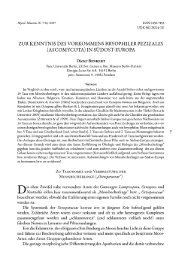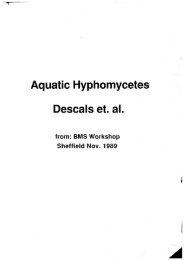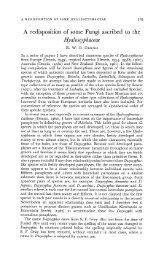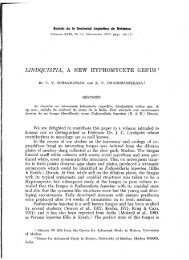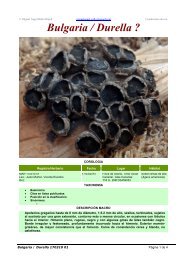Notes on British species of Geopora - ASCOfrance
Notes on British species of Geopora - ASCOfrance
Notes on British species of Geopora - ASCOfrance
Create successful ePaper yourself
Turn your PDF publications into a flip-book with our unique Google optimized e-Paper software.
<str<strong>on</strong>g>Notes</str<strong>on</strong>g> <strong>on</strong> <strong>British</strong> <strong>species</strong> <strong>of</strong> <strong>Geopora</strong><br />
Y.-J. YAO<br />
1<br />
2<br />
1 2<br />
AND B. M. SPOONER 1<br />
Royal Botanic Gardens, Kew, Richm<strong>on</strong>d, Surrey TW9 3AE, U.K.<br />
School <strong>of</strong> Biomolecular Sciences, Liverpool John Moores University, Byrom Street, Liverpool L3 3AT-, U.K.<br />
Five <strong>species</strong> <strong>of</strong> <strong>Geopora</strong> are recognized from Great Britain. <str<strong>on</strong>g>Notes</str<strong>on</strong>g> <strong>on</strong> the nomenclature and tax<strong>on</strong>omy <strong>of</strong> these <strong>species</strong> and <strong>of</strong> those<br />
others in the <strong>British</strong> checklist are presented and lectotypes for both Peziza sumneriana and P. lanuginosa var. sumneri are also<br />
designated.<br />
Seven <strong>species</strong> <strong>of</strong> <strong>Geopora</strong> Harkn., and two <strong>species</strong> and <strong>on</strong>e<br />
variety <strong>of</strong> the syn<strong>on</strong>ym Sepultaria (Cooke) Boud. are included<br />
in the checklist <strong>of</strong> <strong>British</strong> Ascomycotina (Cann<strong>on</strong>, Hawksworth<br />
& Sherwood-Pike, 1985). Investigati<strong>on</strong> <strong>of</strong> these taxa for the<br />
'Ascomycetes <strong>of</strong> Great Britain and Ireland' project shows that<br />
<strong>on</strong>ly five <strong>species</strong> <strong>of</strong> <strong>Geopora</strong>, G. arenicola (Lev.) Kers, G. cervina<br />
(Velen.) T. Schumach., G. foliacea (Schaeff.) S. Ahmad, G.<br />
sumneriana (Cooke) M. Torre and G. tenuis (Fuckel) T.<br />
Schumach., can be recognized from <strong>British</strong> material. <str<strong>on</strong>g>Notes</str<strong>on</strong>g> <strong>on</strong><br />
the nomenclature and tax<strong>on</strong>omy <strong>of</strong> these <strong>species</strong> and <strong>of</strong> the<br />
others in the <strong>British</strong> list are presented here. For syn<strong>on</strong>yms,<br />
<strong>on</strong>ly those which appear in the <strong>British</strong> literature are listed,<br />
although some recent combinati<strong>on</strong>s are included to indicate<br />
the tax<strong>on</strong>omic and nomenclatural history <strong>of</strong> the tax<strong>on</strong><br />
c<strong>on</strong>cerned.<br />
<strong>Geopora</strong> arenicola (Lev.) Kers in Svensk Bot. Tidskr. 68: 345<br />
(1974).<br />
Peziza arenicola Lev. in Ann. Sci. Nat. Bot. ser 3, 9: 140 (1848).<br />
Sepultaria arenicola (Lev.) Massee, Brit. Fung.-Fl. 4: 390 (1895).<br />
There is clearly a varied c<strong>on</strong>cept <strong>of</strong> this <strong>species</strong> am<strong>on</strong>gst<br />
different authors. Some (e.g. Seaver, 1928; Lundell &<br />
Nanrifeldt, 1941; Kers, 1974) have a broad c<strong>on</strong>cept and<br />
include a l<strong>on</strong>g list <strong>of</strong> syn<strong>on</strong>yms under this name. However,<br />
examinati<strong>on</strong> <strong>of</strong> type or authentic material <strong>of</strong> some <strong>of</strong> these<br />
suggested syn<strong>on</strong>yms reveals the inclusi<strong>on</strong> <strong>of</strong> some well<br />
separated <strong>species</strong>, e.g. Peziza arenosa Fuckel and Peziza sepulta<br />
Fr. (see below). Based <strong>on</strong> the examinati<strong>on</strong> <strong>of</strong> the isotype<br />
[Peziza arenicola Lev., Bois de Boulogne, K) and some <strong>British</strong><br />
collecti<strong>on</strong>s, G. arenicola is delimited here as having small<br />
subterranean apothecia, with ellipsoid to el<strong>on</strong>gate ellipsoid<br />
ascospores 20-0-25-5(-26-5) x (ll-5-)12-0-15-0 um. This<br />
<strong>species</strong> was presented under Sepultaria arenosa (Fuckel) Boud.<br />
sensu Seaver in Dennis (1960, 1978).<br />
<strong>Geopora</strong> arenosa (Fuckel) S. Ahmad in M<strong>on</strong>ogr. Biol. Soc.<br />
Pakistan 7: 176 (1978).<br />
Peziza arenosa Fuckel, Fungi Rhen. Exsic. No. 1212 (1865).<br />
Sepultaria arenosa (Fuckel) Rehm in Rahenh. Krypt.-Fl. 1(3):<br />
1077 (1895).<br />
Type material <strong>of</strong> this <strong>species</strong> (Fuckel's Fungi Rhenani exsiccati,<br />
No. 1212, K) has large, ellipso-fusoid ascospores (27-0-<br />
30-5 x 13'5—15-0 pm). It should not be regarded as a syn<strong>on</strong>ym<br />
<strong>of</strong> G. arenicola, though it could prove to be c<strong>on</strong>specific with<br />
the <strong>British</strong> material named G. sumneriana. See further discussi<strong>on</strong><br />
under that <strong>species</strong> below.<br />
<strong>Geopora</strong> cervina (Velen.) T. Schumach. in Norwegian J. Bot.<br />
26: 55 (1979).<br />
Sepultaria cervina Velen., M<strong>on</strong>ogr. Discomyc. Bohem.: 318<br />
(1934).<br />
The <strong>British</strong> record <strong>of</strong> this <strong>species</strong> is based <strong>on</strong> a herbarium<br />
specimen named by T. Schumacher (Ben Hope, W-facing<br />
crags, 27 Aug. 1984, B. J. Coppins & O. L. Gilbert, No. 10283,<br />
E). Examinati<strong>on</strong> <strong>of</strong> this and an additi<strong>on</strong>al collecti<strong>on</strong> (unlabelled,<br />
E) from Scotland shows it to represent a <strong>species</strong> distinct from<br />
other <strong>British</strong> <strong>Geopora</strong>, having el<strong>on</strong>gate-ellipsoid to ellipso-<br />
fusoid ascospores 2T5-27'0(-29-0) x 10-0-13-5 pm. How<br />
ever, these collecti<strong>on</strong>s have spores which lack pointed ends<br />
and, in this respect, do not agree entirely with the c<strong>on</strong>cept <strong>of</strong><br />
G. cervina circumscribed by Schumacher (1979).<br />
<strong>Geopora</strong> foliacea (Schaeff.) S. Ahmad in M<strong>on</strong>ogr. Biol. Soc.<br />
Pakistan 7: 175 (1978).<br />
Elvela foliacea Schaeff., Fung. Bavar. Palat. Nasc. 4: 113, Tab.<br />
319 (1774).<br />
Sepultaria foliacea (Schaeff.) Boud., Ic<strong>on</strong>. Mycol. Liste Prelim.: (3)<br />
[without paginati<strong>on</strong>] (1904).<br />
The basi<strong>on</strong>ym reference for the combinati<strong>on</strong> <strong>of</strong> this <strong>species</strong> in<br />
<strong>Geopora</strong> was given by Ahmad (1978) as ' = Sepultaria foliacea<br />
Schaeff., Fung. Tab. CCCIX; ex Boud., Ic<strong>on</strong>. Mycol. Tom. II PI.<br />
359.-Hist. Class. Disc. Eur.: 59. 1907'. This citati<strong>on</strong> is<br />
acceptable in view <strong>of</strong> the ICBN operating at that time,<br />
although there are several bibliographic errors. However, the<br />
name, Sepultaria foliacea (Schaeff.) Boud., does appear <strong>on</strong> the
Y.-J. Yao and B. M. Spo<strong>on</strong>er 73<br />
plate and page which Ahmad (1978) cited from Boudier's<br />
work. The correct bibliographic citati<strong>on</strong> required by the<br />
current Code (Greuter et al, 1994) is provided above.<br />
No type or authentic material <strong>of</strong> this <strong>species</strong> has been<br />
studied in this investigati<strong>on</strong>. We apply this name to <strong>British</strong><br />
collecti<strong>on</strong>s having obl<strong>on</strong>g-ellipsoid, <strong>of</strong>ten parallel-sided asco<br />
spores (23-0-)25-0-27-0(-28-5) x (ll-0-)12-0-14-0(-15-0) um.<br />
Examinati<strong>on</strong> <strong>of</strong> an authentic specimen (in Herb. Cooke, K)<br />
<strong>of</strong> Peziza lanuginosa Bull. (Hist. Champ. France: 260, Pi. 396, Fig.<br />
2 (1791)), listed as a syn<strong>on</strong>ym <strong>of</strong> Sepultaria foliacea by Boudier<br />
(1904, 1907) and having priority over Elvela foliacea, shows it<br />
to be referable to Humaria hemisphaerica (F. H. Wigg.) Fuckel.<br />
<strong>Geopora</strong> sepulta (Fr.) Korf & Burds. in Burdsall in Mycologia<br />
60: 500 (1968).<br />
Peziza sepulta Fr. in Nova Acta Regiae Soc. Sci. Upsaliensis III, 1:<br />
230 (1851).<br />
Sepultaria sepulta (Fr.) Massee, Brit. Fung.-Fl. 4: 389 (1895).<br />
Lachnea sepulta (Fr.) W. Phillips, Man. Brit. Discomyc.: 209<br />
(1887).<br />
The c<strong>on</strong>cept <strong>of</strong> this <strong>species</strong> adopted by <strong>British</strong> authors, with<br />
ascospores 22-0-24-0 x 12-0 um (Cooke, 1876; Phillips, 1887)<br />
or 18-0-22-0 x 10-0-12-0 um (Massee, 1895), is not that<br />
represented by material from Fries (Sweden, Horto Upsaliensi,<br />
ex Herb. Fries, K). Fries' material has larger, broadly ellipsoid<br />
spores 25-0-28-0(-29-5) x (15-0-)16-0-18-0(-19-0) um. Exam<br />
inati<strong>on</strong> <strong>of</strong> the <strong>British</strong> specimen cited by Cooke (1876)<br />
('Phillips, E. B. 63', now in K) shows it to be referable to G.<br />
foliacea. No <strong>British</strong> material examined has such large and<br />
broadly ellipsoid spores as those <strong>of</strong> the material from Fries.<br />
Although it has been regarded as a syn<strong>on</strong>ym <strong>of</strong> G. arenicola<br />
(Lundell & Nannfeldt, 1941; Kers, 1974; Moreno, Galan &<br />
Ortega, 1986; Zhang & Yu, 1992), we c<strong>on</strong>sider that G. sepulta<br />
is an independent <strong>species</strong> which is not yet known from Britain.<br />
<strong>Geopora</strong> sumneriana (Cooke) M. Torre in Anal. Inst. Bot.<br />
Cavanilles 32(2): 96 (1976).<br />
Peziza sumneriana Cooke, Mycographia 1: 178 (1877) [with<br />
descripti<strong>on</strong> <strong>on</strong> p. 63 under the name Peziza (Sarcoscypha)<br />
lanuginosa var. Sumneri Berk. & Br. and Fig. Ill under the<br />
name Peziza lanuginosa Bull. (1876)].<br />
Lachnea sumneriana (Cooke) W. Phillips, Man. Brit. Discomyc.:<br />
213 (1887).<br />
Sepultaria sumneriana (Cooke) Massee, Brit. Fung.-Fl. 4: 391<br />
(1895).<br />
Peziza lanuginosa var. sumneri Berk. & Broome in Berkeley in<br />
Trans. Linn. Soc. L<strong>on</strong>d<strong>on</strong> 25: 432, PI. 55, Fig. 1 (1866).<br />
Sepultaria sumneri (Berk. & Broome) Boud., Hist. Classfic.<br />
Discomyc. Europe: 59 (1907).<br />
This fungus was first named as Peziza lanuginosa var. sumneri<br />
(Berkeley, 1866; Berkeley & Broome, 1866), but renamed as P.<br />
sumneriana by Cooke (1877), referring to <strong>on</strong>e <strong>of</strong> his figures <strong>of</strong><br />
P. lanuginosa (Cooke, 1876: Fig. Ill) and his previous text for<br />
P. lanuginosa var. sumneri (Cooke, 1876). The varietal name, P.<br />
lanuginosa var. sumneri, has no priority over Cooke's <strong>species</strong><br />
name (ICBN, Art. 11.2). Later combinati<strong>on</strong>s should have cited<br />
Cooke (1877) as the reference but all <strong>of</strong> them cited <strong>on</strong>ly<br />
Cooke's Fig. 111.<br />
The combinati<strong>on</strong> <strong>of</strong> <strong>Geopora</strong> sumneriana by De La Torre<br />
(1975) may be regarded as invalid due to failure in<br />
bibliographic research rather than merely a bibliographic error<br />
as c<strong>on</strong>sidered by Moreno, Galan & Ortega (1986). The<br />
basi<strong>on</strong>ym reference cited by De La Torre (1975) as 'Peziza<br />
lanuginosa var. sumneri Berk, et Br., in Ann. N.H. num. 1161, t.<br />
4, /. 25 (1866), Peziza sumneriana Cook., in Mycographia seu<br />
t<strong>on</strong>es Fungorum vol. 1, p. 63, fig. Ill (1879)' is not simply an<br />
error <strong>of</strong> citati<strong>on</strong> <strong>of</strong> page number <strong>of</strong> the publicati<strong>on</strong>. The name<br />
Peziza sumneriana does not appear <strong>on</strong> the page and the plate<br />
he cited. De La Torre (1975) apparently repeated the mistakes<br />
made by earlier authors in pre-1953 combinati<strong>on</strong>s. If De La<br />
Torre missed the correct page in Cooke's work, she should have<br />
found this from the Sylloge Fungorum (Saccardo, 1889), where<br />
'Lachnea Sumneriana Cooke Mycogr. f. Ill, erf. p. 178 (Pez.),<br />
Pez. lanuginosa var. Sumneri Berk. Linn. Trans. XXV, t. 55, f. 1.'<br />
was listed. If some fundamental works <strong>on</strong> fungal tax<strong>on</strong>omy<br />
were not c<strong>on</strong>sulted for a new combinati<strong>on</strong> it should not be<br />
regarded as a bibliographic error.<br />
Sepultaria sumneri (Berk. & Broome) Boud., raising the<br />
original varietal epithet, is treated as an independent<br />
combinati<strong>on</strong>. Boudier listed 'Sepultaria Sumneriana Cooke' in<br />
his Ic<strong>on</strong>es Mycologicae, Liste Prelim.: (3) [without paginati<strong>on</strong>]<br />
(1904), but he used 'Sepultaria Sumneri (Berk.) Cooke' in the<br />
Texte preliminaire <strong>of</strong> the work (Ser. 6, Livr. 26, p. 7 (1909)), the<br />
Provisiores des planches No. 522 (Tom II, Pi. 358) and the final<br />
Texte descriptif (Vol. 4: 200 (1910)). The combinati<strong>on</strong> in Ic<strong>on</strong>es<br />
Mycologicae, Liste Prelim, repeated Massee's combinati<strong>on</strong>,<br />
whilst the combinati<strong>on</strong> in Hist. Classific. Discomyc. Europe: 59<br />
(1907), followed in the later publicati<strong>on</strong> <strong>of</strong> Ic<strong>on</strong>es Mycologicae<br />
can be credited, as a separate combinati<strong>on</strong>, to Boudier as he<br />
adopted Berkeley & Broome's epithet rather than that <strong>of</strong><br />
Cooke.<br />
The collecti<strong>on</strong>s cited for Peziza lanuginosa var. sumneri by<br />
Cooke (1876) (Cooke, F. B. i., 471, ii., 362; Phillips, E. B. 62<br />
and Rabh. F. E. 1419) should be regarded as syntypes <strong>of</strong> P.<br />
sumneriana. Cooke Fungi Britannici exsiccati 1st ed., No. 471<br />
(Warwick, April 1870, several parts in K) is selected here as<br />
the lectotype <strong>of</strong> P. sumneriana as Fig. Ill in Mycographia was<br />
based <strong>on</strong> this collecti<strong>on</strong>, cited as 'Guy's Cliff, Warwick' in<br />
Cooke (1876). The specimen labelled as 'Chiswick House, Mr.<br />
Edm<strong>on</strong>ds, May 1866' in Herb. Berkeley (K) is also herewith<br />
designated as the lectotype <strong>of</strong> P. lanuginosa var. sumneri as it<br />
is <strong>on</strong>e <strong>of</strong> the two collecti<strong>on</strong>s cited in the protologue. Both <strong>of</strong><br />
these lectotypes display the same features, having large<br />
apothecia 30—70 mm diam. and ellipso-fusoid ascospores<br />
27-0-33-0(-35-5) x 12-5-15-0(-15-5) um. These characters are<br />
reminiscent <strong>of</strong> G. arenosa as menti<strong>on</strong>ed above. We do not<br />
syn<strong>on</strong>ymize these two names because P. sumneriana occurs in<br />
January to May, <strong>of</strong>ten under Cedrus, whilst <strong>Geopora</strong> arenosa<br />
was described as 'in pinetis' and 'Autumno' (Fuckel, 1865,<br />
1866). We prefer to c<strong>on</strong>tinue using the well established name<br />
in <strong>British</strong> literature for this fungus pending further<br />
investigati<strong>on</strong>.<br />
<strong>Geopora</strong> tenuis (Fuckel) T. Schumach. in Norwegian ]. Bot.<br />
26:56 (1979).<br />
Humaria tenuis Fuckel in ]b. nassau. Ver-Naturk. 23—24.: 322<br />
(1870).<br />
Peziza tenuis (Fuckel) Cooke in Grevillea 3: 73, Fig. 97 (1874).
<strong>British</strong> <strong>Geopora</strong> 74<br />
Sepultaria tenuis (Fuckel) Boud., Ic<strong>on</strong>. Mycol, Liste Prelim.: (3)<br />
[without paginati<strong>on</strong>] (1904).<br />
The lectotype <strong>of</strong> this <strong>species</strong> designated by Schumacher<br />
(1979) is in fact the holotype as <strong>on</strong>ly <strong>on</strong>e collecti<strong>on</strong> ('F. rh.<br />
2289') was menti<strong>on</strong>ed in the protologue. The c<strong>on</strong>cept <strong>of</strong><br />
Dennis (1960, 1978) for this <strong>species</strong> is followed here but with<br />
l<strong>on</strong>ger apothecial hairs than those described from the type<br />
(Schumacher, 1979). The example <strong>of</strong> Fuckel's Fungi Rhenani<br />
No. 2289 in K is exhausted and no other authentic material <strong>of</strong><br />
this <strong>species</strong> has been seen by the present authors.<br />
Sepultaria arenicola var. bloxamii (Cooke) Boud., Hist.<br />
Classific. Discomyc. Europe: 59 (1907).<br />
Peziza arenosa var. bloxamii Cooke, Mycographia 1: 68, Fig.<br />
121 (1876) [as 'bloxami'}.<br />
Lachnea arenicola var. bloxamii (Cooke) W. Phillips, Man. Brit.<br />
Discomyc: 211 (1887) [as:•''bloxami').<br />
Examinati<strong>on</strong> <strong>of</strong> the type <strong>of</strong> this tax<strong>on</strong> labelled ' Peziza sepulta,<br />
Liverpool' in K shows it to have ellipsoid to el<strong>on</strong>gate-ellipsoid<br />
ascospores 22-0-25-5(-27-0) x 13-0-15-0 pm. We agree with<br />
Massee (1895) that this is a syn<strong>on</strong>ym <strong>of</strong> G. arenicola.<br />
Boudier (1907) referred his combinati<strong>on</strong> to Cooke's<br />
Mycographia Fig. 121, but also err<strong>on</strong>eously to Saccardo's Syll.<br />
Fung. 11: 393, where Geopyxis bloxamii [as 'bloxami'} Massee<br />
(Grevillea 22: 98, 1894) was listed. Massee's <strong>species</strong>, from<br />
Oxford (Baxter), <strong>on</strong> the ground, was described without any<br />
c<strong>on</strong>necti<strong>on</strong> with Cooke's fungus which was from near<br />
Liverpool, am<strong>on</strong>gst sand.<br />
Sepultaria geaster (Berk. & Broome) Boud., Hist. Class.<br />
Discomyc. Europe: 59 (1907).<br />
Peziza geaster Berk. & Broome in Ann. Mag. Nat. Hist. Ser. 3,<br />
7: 449 (1861), n<strong>on</strong> Rabenhorst (1867).<br />
Lachnea geaster (Berk. & Broome) W. Phillips, Man. Brit.<br />
Discomyc: 210 (1887).<br />
The holotype material, labelled as 'Peziza geaster B. & B.,<br />
Wentworth, Oct. 9 1858', in K, displays ellipsoid to<br />
el<strong>on</strong>gate ellipsoid ascospores 22-0—25-5 x 13-0—14-5 pm, and<br />
represents G. arenicola. We agree with Lundell & Nannfeldt<br />
(1941) and with Kers (1974), who treated P. geaster as a<br />
syn<strong>on</strong>ym <strong>of</strong> G. arenicola. It may be noted that this tax<strong>on</strong> was<br />
published as a new <strong>species</strong> twice by the same authors<br />
(Berkeley & Broome, 1861, 1866).<br />
Sepultaria semiimmersa (P. Karst.) Massee, Brit. Fung. -F/.4:<br />
391 (1895).<br />
Peziza semiimmersa P. Karst., Not. Fauna Fl. Fenn. 10: 117<br />
(1869).<br />
Humaria semiimmersa (P. Karst.) Sacc, Syll. Fung. 8: 143<br />
(1889).<br />
Leucoscypha semiimmersa (P. Karst.) Svrcek in Ceskd Mykol 28:<br />
133 (1974).<br />
Octospora semiimmersa (P. Karst.) K. B. Khare & V. P. Tewari in<br />
Can. J. Bot. 56: 2118 (21 Sept. 1978).<br />
Octospora semiimmersa (P. Karst.) S. Ahmad, M<strong>on</strong>ogr. Biol. Soc.<br />
Pakistan 7: 183 (1978).<br />
(Accepted 24 June 1995)<br />
Byss<strong>on</strong>ectria semiimmersa (P. Karst.) Benkert in Gledilschia 15:<br />
181 (1987).<br />
This is a reddish <strong>species</strong>, out <strong>of</strong> place in <strong>Geopora</strong>. It appears to<br />
be c<strong>on</strong>generic with Peziza patavina Cooke, and further<br />
investigati<strong>on</strong> is required to establish an appropriate generic<br />
placement for these two <strong>species</strong>.<br />
We thank R. K. Brummitt (Royal Botanic Gardens, Kew) for<br />
nomenclatural discussi<strong>on</strong>s and Pr<strong>of</strong>essor D. L. Hawksworth<br />
(Internati<strong>on</strong>al Mycological Institute, Egham) for general<br />
comments <strong>on</strong> the manuscript. This work is supported by a<br />
grant (GR3/8284) from the Natural Envir<strong>on</strong>ment Research<br />
Council for the project 'The Ascomycetes <strong>of</strong> Great Britain and<br />
Ireland'.<br />
REFERENCES<br />
Ahmad, S. (1978). Ascomycetes <strong>of</strong> Pakistan, Part I. Biological Society <strong>of</strong> Pakistan<br />
M<strong>on</strong>ograph No. 7. Biological Society <strong>of</strong> Pakistan: Lahore, Pakistan.<br />
Berkeley, M. J. (1866). On two new <strong>British</strong> fungi. Transacti<strong>on</strong>s <strong>of</strong> the Linnean<br />
Society 25, 431-432.<br />
Berkeley, M. J. & Broome, C. E. (1861). Notices <strong>of</strong> <strong>British</strong> fungi. The Annals<br />
and Magazine <strong>of</strong> Natural History 7, 449-456.<br />
Berkeley, M. J. & Broome, C. E. (1866). Notices <strong>of</strong> <strong>British</strong> fungi. The Annals<br />
and Magazine <strong>of</strong> Natural History 18, 121-129.<br />
Boudier, E. (1904). Ic<strong>on</strong>es Mycologicae. Ser. 1, Livr. 2. Librairie des Sciences<br />
Naturelles, Paul Klincksieck: Paris.<br />
Boudier, E. (1907). Histoire et Classificati<strong>on</strong> des Discomycetes d'Europe. Librarie<br />
des Sciences Naturelles, Klincksieck: Paris.<br />
Cann<strong>on</strong>, P. F., Hawksworth, D. L. & Sherwood-Pike, M. A. (1985). The <strong>British</strong><br />
Ascomycotina, an annotated checklist. Comm<strong>on</strong>wealth Agricultural Bureaux:<br />
Slough, U.K.<br />
Cooke, M. C. (1876). Mycographia, seu Ic<strong>on</strong>es Fungorum. Williams & Norgate:<br />
L<strong>on</strong>d<strong>on</strong>. 1, 45-86.<br />
Cooke, M. C. (1877). Mycographia, seu Ic<strong>on</strong>es Fungorum. Williams & Norgate:<br />
L<strong>on</strong>d<strong>on</strong>. 1, 137-178.<br />
De La Torre, M. (1975). Estudio sobre Discomycetes operculados: clave y<br />
generos nuevos para la flora Espanola Peninsular. Instituto Botanico Ant<strong>on</strong>io<br />
Jose Cavanilles 32, 85-101.<br />
Dennis, R. W. G. (1960). <strong>British</strong> Cup Fungi and their Allies, An introducti<strong>on</strong> to<br />
the Ascomycetes. Ray Society: L<strong>on</strong>d<strong>on</strong>.<br />
Dennis, R. W. G. (1978). <strong>British</strong> Ascomycetes, 2nd ed. ]. Cramer: Vaduz,<br />
Germany.<br />
Fuckel, L. (1865). Fungi Rhenani exsiccati. Cent. 12-17, No. 1101-1700.<br />
Fuckel, L. (1866). Fungi Rhenani exsiccati. Cent. 12-17, No. 1101-1700.<br />
Hedwigia 5: 14-16.<br />
Greuter, W., Barrie, F. R., Burdet, H. M„ Chal<strong>on</strong>er, W. G„ Demoulin, V.,<br />
Hawksworth, D. L., Jorgensen, P. M., Nicols<strong>on</strong>, D. H., Silva, P. C, Trehane,<br />
P. & Mcneill, J. (1994). Internati<strong>on</strong>al Code <strong>of</strong> Botanical Nomenclature. Koeltz<br />
Scientific Books: K<strong>on</strong>igstein, Germany.<br />
Kers, L. E. (1974). The Swedish <strong>Geopora</strong>e and their Pyrenomycete infecti<strong>on</strong>s.<br />
Svensk Botanisk Tidskrift 68, 344-354.<br />
Lundell, S. & Nannfeldt, J. A. (1941). Fungi exsiccati Suecici, praesertim<br />
Upsalienses, Fasc. XIX-XX.<br />
Massee, G. (1895). <strong>British</strong> Fungus Flora. A Classified Text-book <strong>of</strong> Mycology, Vol.<br />
4. George Bell & S<strong>on</strong>s: L<strong>on</strong>d<strong>on</strong>.<br />
Moreno, G., Galan, R. & Ortega, A. (1986). Hypogeous fungi from<br />
c<strong>on</strong>tinental Spain. I. Cryptogamie Mycologie 7, 201-229.<br />
Phillips, W. (1887). A Manual <strong>of</strong> the <strong>British</strong> Discomycetes. Kegan Paul, Trench &<br />
Co: L<strong>on</strong>d<strong>on</strong>.<br />
Saccardo, P. A. (1889). Sylloge Fungorum, Vol. 8. Sacccardo: Patavia.<br />
Schumacher, T. (1979). <str<strong>on</strong>g>Notes</str<strong>on</strong>g> <strong>on</strong> tax<strong>on</strong>omy, ecology, and distributi<strong>on</strong> <strong>of</strong><br />
operculate discomycetes (Pezizales) from river banks in Norway. Norwegian<br />
Journal <strong>of</strong> Botany 26, 53-83.<br />
Seaver, F. J. (1928). The North American Cup-fungi (Operculates). Seaver: New<br />
York.<br />
Zhang, B.-C. & Yu, Y.-N. (1992). Revisi<strong>on</strong> <strong>of</strong> Chinese <strong>species</strong> <strong>of</strong> <strong>Geopora</strong><br />
(Pezizales). Acta Mycologia Sinica 11, 8-14.


